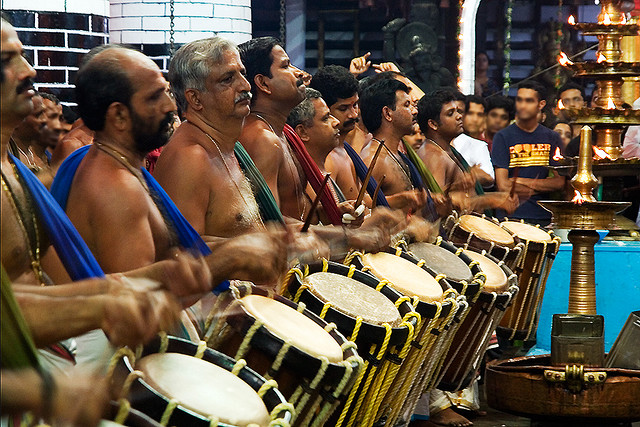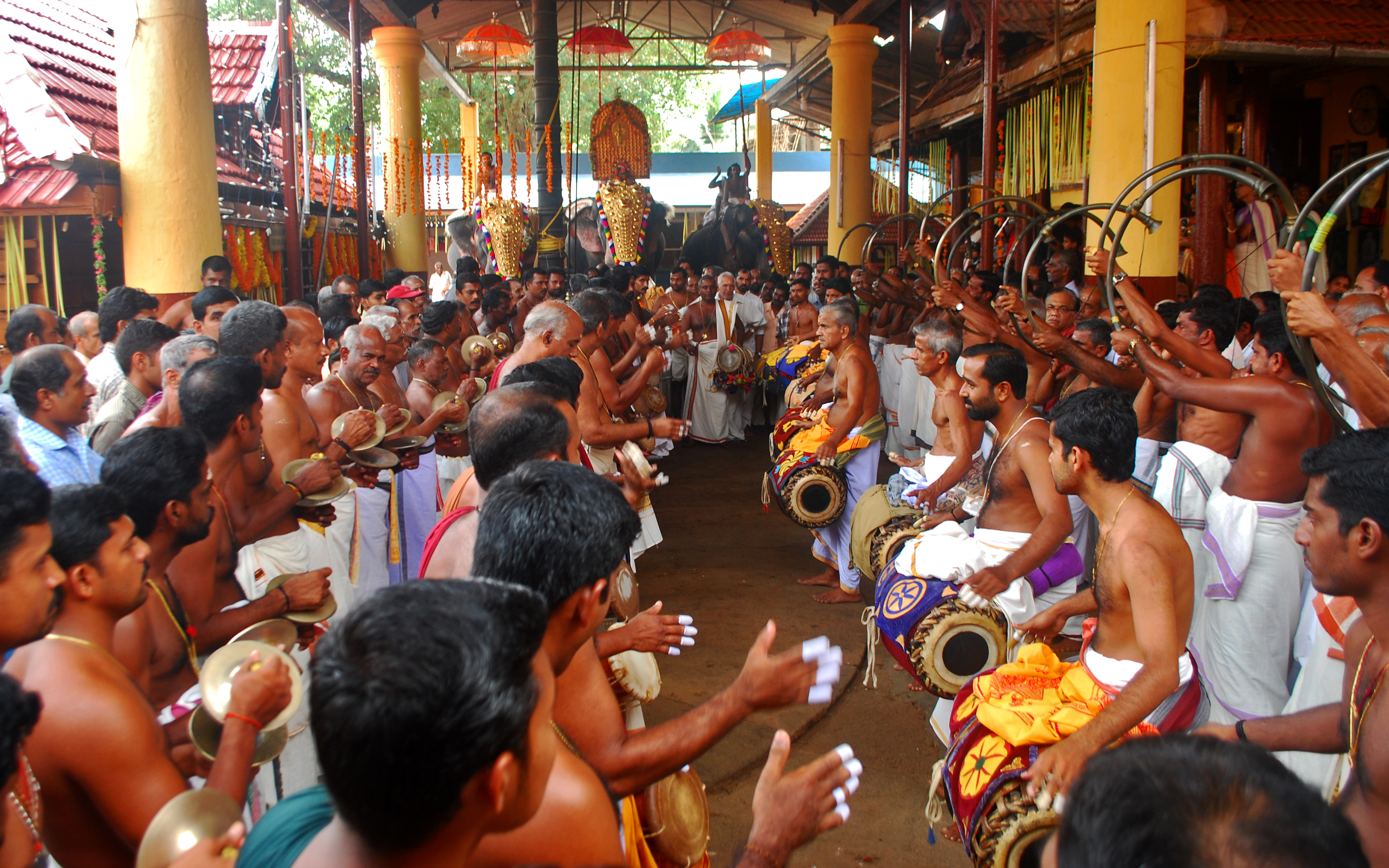|
Pandi Melam
Pandi melam is a classical percussion concert or melam (ensemble) led by the ethnic Kerala instrument called the chenda and accompanied by ilathalam (cymbals), kuzhal and Kombu. A full-length Pandi, a melam based on a thaalam ( taal) with seven beats, lasts more than two-and-a-half hours, and is canonically performed outside temples. It has basically four stages, each of them with rhythmic cycles (thaalavattam) totalling 56, 28, 14 and seven respectively. The most celebrated Pandi Melam is staged inside a temple compound at the ''Vadakkunnathan'' shrine's precincts in the central Kerala town of Thrissur. For the last several years, Peruvanam Kuttan Marar is the lead conductor for this symphony of drums known as ''Elanjithara Melam''. Elsewhere, like in the pooram festivals of Aarattupuzha and Peruvanam near Thrissur and the rest of central and northern Kerala, it is performed outside temples. Another ensemble called Panchari Melam, which is similar to Pandi going by the kin ... [...More Info...] [...Related Items...] OR: [Wikipedia] [Google] [Baidu] |
Kerala
Kerala ( ; ) is a state on the Malabar Coast of India. It was formed on 1 November 1956, following the passage of the States Reorganisation Act, by combining Malayalam-speaking regions of the erstwhile regions of Cochin, Malabar, South Canara, and Thiruvithamkoor. Spread over , Kerala is the 21st largest Indian state by area. It is bordered by Karnataka to the north and northeast, Tamil Nadu to the east and south, and the Lakshadweep Sea to the west. With 33 million inhabitants as per the 2011 census, Kerala is the 13th-largest Indian state by population. It is divided into 14 districts with the capital being Thiruvananthapuram. Malayalam is the most widely spoken language and is also the official language of the state. The Chera dynasty was the first prominent kingdom based in Kerala. The Ay kingdom in the deep south and the Ezhimala kingdom in the north formed the other kingdoms in the early years of the Common Era (CE). The region had been a prominent spic ... [...More Info...] [...Related Items...] OR: [Wikipedia] [Google] [Baidu] |
Chenda
The Chenda ( ml, ചെണ്ട, ) is a cylindrical percussion instrument originating in the state of Kerala and widely used in Tulu Nadu of Karnataka and Tamil Nadu in India. In Tulu Nadu (Coastal Karnataka), it is known as ''chende''. It is greatly identified as a cultural element in Kerala and Tulu Nadu. This instrument is famous for its loud and rigid sound. A Chenda has two sides, the left side called "Edamthala" (ഇടം തല)(Left Head) and the right side "Valamthala" (വലം തല)(Right Head). The "Edamthala" is made of only one/two layer of cow skin and the "Valamthala" will have a five/seven layer skin, so as to have a bass sound. The skin are dried in the shade and fastened on wooden rings (Chenda Vattam, ചെണ്ട വട്ടം) made of the trunk of a locally available palm tree (Eeranpana) or bamboo, using a gum prepared from the seed of a tree called "pananchi maram". The circular frame is kept in a vessel, boiled for an entire day and then ... [...More Info...] [...Related Items...] OR: [Wikipedia] [Google] [Baidu] |
Ilathalam
Elathalam, or Ilathalam, is a metallic musical instrument which resembles a miniature pair of cymbals. This instrument from Kerala in southern India is completely made out of bronze and has two pieces in it. Elathalam is played by keeping one part of the cymbal in left hand banging the other cymbal to the one in left hand. Even though this instrument is small by size, it does have more thickness than the common cymbal, and thus gives a distinct chime. Elathalam is never a lead instrument but is used in a number of ethnic Kerala percussion ensembles like Panchavadyam, Chenda melam, Thayambaka and Kailaya vathiyam besides by second singer on a Kathakali stage beside providing the beat in Kuzhal Pattu and Kombu Pattu. Masters of Elathalam Leading elathalam masters of the present day include:Cheriyath Thanku Marar, Chelakkara Unnikrishnan, Maniyamparambil Mani, Kothachira Sekharan Nair, Chengamanad Paramu Nair, Pallavur Raghava Pisharody, Chelakkara Jayan, Pookottur Sasidharan (Asi ... [...More Info...] [...Related Items...] OR: [Wikipedia] [Google] [Baidu] |
Kuzhal
The kuzhal is a traditional double reed wind instrument used in the south Indian state of Kerala. It is similar in construction to a ''nagaswaram'' or a large ''shehnai'', and has a very shrill and penetrating tone. Kuzhal is primarily used as an accompaniment for chenda-led ensembles Panchari Melam and Pandi Melam, where the piper plays the anchor role. However, as prelude to melams, it is also used to present solo concert (with a couple of accompanying instruments), in which case it is called Kuzhal Pattu. The instrument has a wooden body with a conical bore, at the end of which is affixed a brass bell. The player, who is almost always male, blows through a double reed and closes small holes with both hands. See also * Nadaswaram * Shehnai The ''shehnai'' is a musical instrument, originating from the Indian subcontinent. It is made of wood, with a double reed at one end and a metal or wooden flared bell at the other end. [...More Info...] [...Related Items...] OR: [Wikipedia] [Google] [Baidu] |
Kombu, Kerala
The Kombu (Tamil:கொம்பு, Malayalam: കൊമ്പ്) or Kompu also known as the Kombu Pattu is a wind instrument (a kind of Natural Horn) in Tamil nadu and Kerala. Usually played along with Panchavadyam, Pandi Melam, Panchari melam etc. This musical instrument is usually seen in south India. The instrument is like a long horn (''Kombu'' in Tamil and Malayalam). In ancient days ''kombu'' played during war along with Murasu. History Listed one of the Musical instruments used by ancient Tamil people out in Tirumurai dated 6th to 11th century, Sangam Period. வெல் படைத் தறுகண் வெஞ்சொல் வேட்டுவர் கூட்டம் தோறும் சில்லரித் துடியும் கொம்பும் சிறு கண் ஆகுளியும் கூடி கல் எனும் ஒலியின் மேலும் கறங்கிசை அருவி எங்கும� ... [...More Info...] [...Related Items...] OR: [Wikipedia] [Google] [Baidu] |
Tala (music)
A tala ( IAST ''tāla'') literally means a 'clap, tapping one's hand on one's arm, a musical measure'. It is the term used in Indian classical music similar to musical meter, that is any rhythmic beat or strike that measures musical time. The measure is typically established by hand clapping, waving, touching fingers on thigh or the other hand, verbally, striking of small cymbals, or a percussion instrument in the Indian subcontinental traditions. Along with ''raga'' which forms the fabric of a melodic structure, the ''tala'' forms the life cycle and thereby constitutes one of the two foundational elements of Indian music. ''Tala'' is an ancient music concept traceable to Vedic era texts of Hinduism, such as the '' Samaveda'' and methods for singing the Vedic hymns. The music traditions of the North and South India, particularly the ''raga'' and ''tala'' systems, were not considered as distinct till about the 16th century. There on, during the tumultuous period of Islamic rul ... [...More Info...] [...Related Items...] OR: [Wikipedia] [Google] [Baidu] |
Thrissur
Thrissur (), formerly Trichur, also known by its historical name Thrissivaperur, is a city and the headquarters of the Thrissur district in Kerala, India. It is the third largest urban agglomeration in Kerala after Kochi and Kozhikode, and the 21st largest in India. The city is built around a hillock called the Thekkinkaadu Maidaanam which seats a large Hindu Shiva Temple. It is located central of the state, and north-west of the state's capital city, Thiruvananthapuram. Thrissur was once the capital of the Kingdom of Cochin, and was a point of contact for the Assyrians, Greeks, Persians, Arabs, Romans, Portuguese, Dutch and English. Thrissur is also known as the Cultural Capital of Kerala because of its cultural, spiritual and religious leanings throughout history. The city centre contains the Kerala Sangeetha Nadaka Academy, Kerala Lalithakala Akademi and Kerala Sahitya Academy. The city hosts the Thrissur Pooram festival, the most colourful and spectacular temple festi ... [...More Info...] [...Related Items...] OR: [Wikipedia] [Google] [Baidu] |
Peruvanam Kuttan Marar
Peruvanam Kuttan Marar is a chenda artist. He leads several popular traditional orchestra performances in Kerala. He received Padma Shri, India's third highest civilian award, in 2011 for his contributions in the field of art. Early life Peruvanam Kuttan Marar was born to a family of chenda artists in Peruvanam, Thrissur, Kerala. His grandfather, Peruvanam Narayana Marar and his father, Peruvanam Appu Marar were also well-known chenda artists. His teachers include his father, Kumarapuram Appu Marar and Sreenarayanapuram Appu Marar. He made his debut with Chenda at the age of 10. He performed at festivals in nearby temples including Peruvanam Mahadeva Temple. He also joined as a clerk in C N N Boys' High School, Cherpu at the age of 20. Career as an artist Kuttan Marar features in prominent temple festivals of Kerala including Thrissur Pooram, Peruvanam pooram, Kollam Pooram and those at Guruvayur Temple. He leads the famous Ilanjithara Melam of Thrissur Pooram. Kuttan Mar ... [...More Info...] [...Related Items...] OR: [Wikipedia] [Google] [Baidu] |
Panchari Melam
Panchari Melam is a percussion ensemble, performed during temple festivals in Kerala, India. Panchari Melam (or simply panchari), is one of the major forms of Chenda Melam (ethnic drum ensemble), and is the best-known and most popular in the ''kshetram vadyam'' (temple percussion) genre. Panchari Melam, comprising instruments like Chenda, Ilathalam, Kombu and Kuzhal, is performed during many temple festivals in central Kerala, where it is presented in arguably the most classical manner. Panchari is also traditionally performed, albeit with a touch of subtle regional difference, in north Kerala (Malabar) and south-central Kerala (Kochi). Of late, its charm has led to its performance even in temples in Kerala's deep south. Panchari is a six-beat thaalam ( taal) with equivalents like Roopakam in south Indian Carnatic music and Daadra in the northern Hindustani classical. Another Chenda Melam which comes close to Panchari in prominence and grammatical soundness, is Pandi Melam, pe ... [...More Info...] [...Related Items...] OR: [Wikipedia] [Google] [Baidu] |
Panchari Melam
Panchari Melam is a percussion ensemble, performed during temple festivals in Kerala, India. Panchari Melam (or simply panchari), is one of the major forms of Chenda Melam (ethnic drum ensemble), and is the best-known and most popular in the ''kshetram vadyam'' (temple percussion) genre. Panchari Melam, comprising instruments like Chenda, Ilathalam, Kombu and Kuzhal, is performed during many temple festivals in central Kerala, where it is presented in arguably the most classical manner. Panchari is also traditionally performed, albeit with a touch of subtle regional difference, in north Kerala (Malabar) and south-central Kerala (Kochi). Of late, its charm has led to its performance even in temples in Kerala's deep south. Panchari is a six-beat thaalam ( taal) with equivalents like Roopakam in south Indian Carnatic music and Daadra in the northern Hindustani classical. Another Chenda Melam which comes close to Panchari in prominence and grammatical soundness, is Pandi Melam, pe ... [...More Info...] [...Related Items...] OR: [Wikipedia] [Google] [Baidu] |
Panchavadyam
Panchavadyam (Malayalam: പഞ്ചവാദ്യം), literally meaning an orchestra of five instruments, is basically a temple art form that has evolved in Kerala. Of the five instruments, four — timila, maddalam, ilathalam and idakka — belong to the percussion category, while the fifth, kombu, is a wind instrument. Much like any chenda melam, panchavadyam is characterised by a pyramid-like rhythmic structure with a constantly increasing tempo coupled with a proportional decrease in the number of beats in cycles. However, in contrast to a chenda melam, panchavadyam uses different instruments (though ilathalam and kompu are common to both), is not related very closely to any temple ritual and, most importantly, permits much personal improvisation while filling up the rhythmic beats on the timila, maddalam and idakka. Panchavadyam bases itself on the seven-beat thripuda (also spelt thripuda) thaalam ( taal) but amusingly sticks to the pattern of the eight-beat chempata ... [...More Info...] [...Related Items...] OR: [Wikipedia] [Google] [Baidu] |


.jpg)
.jpg)



